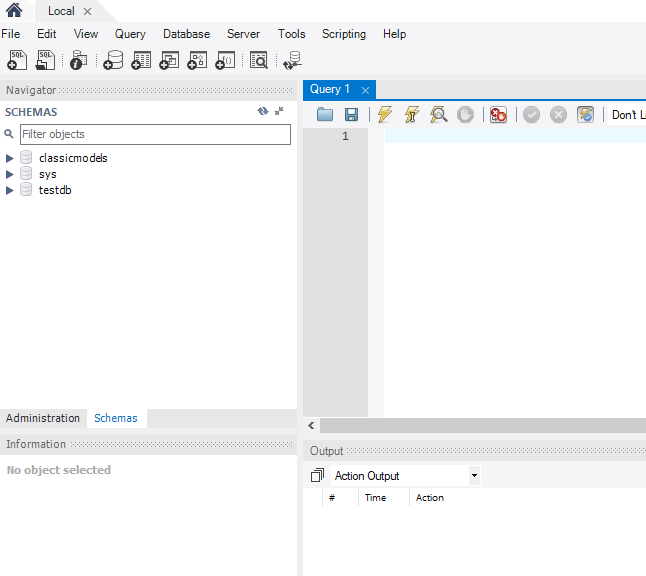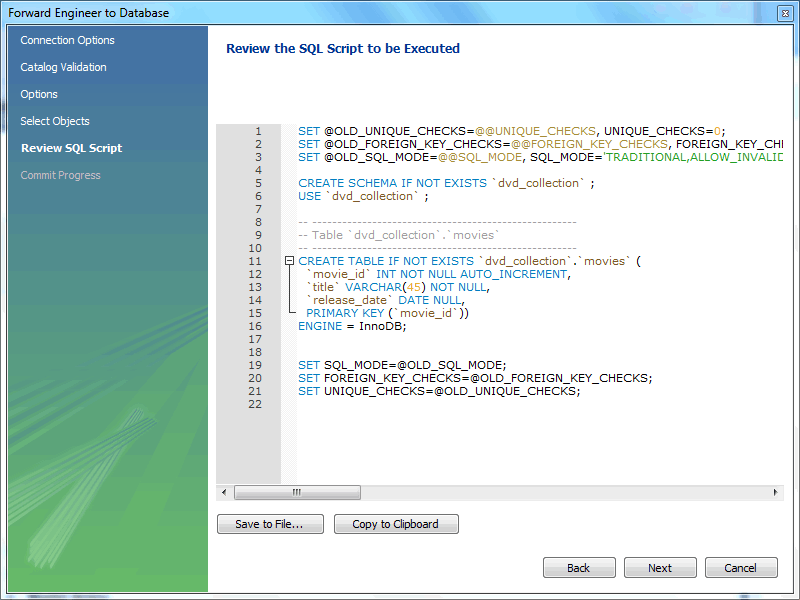
- #Create database workbench how to
- #Create database workbench manual
- #Create database workbench password
A good example here if you do not have any existing databases is to reverse engineer the mysql database (the database used internally by MySQL). Having connected successfully and fetched the database information proceed to the next screen to select the schemata to be reverse engineered.

To reverse engineer an existing database, select the Create EER Model from Existing Database link from the Database Modeling column of the MySQL Workbench home screen and configure the connection to the desired database server in the resulting dialog. In addition to aiding in the design of new models, a model may also be generated from an existing database (a concept referred to as reverse engineering). Assuming a successful operation, the new database will now be present on the designated database server. The success or otherwise of the execution will then be reported in the following screen.
#Create database workbench password
Select the stored connection to which the script is to be sent together with any other connection parameters that are required, click on Execute and enter the password if required to do so. Since this is a very simple example, and all we have to generate is table information, select only the Export MySQL Table Objects option and click Next to review the generated SQL script:Īssuming the script appears as expected given the initial model from which it has been generated, click Next to specify the server to which the script is to be sent (or save the script if it is to be used later, perhaps within the SQL Editor or mysql client):

In addition, the objects that are to be generated may also be selected. Unless you have specific requirements, leave the default selections unchanged. In the resulting dialog, a range of selections are available to filter and modify the script that will ultimately be generated. To achieve this, select the Database -> Forward Engineer… menu option. Having created a model, the next step is to generate a SQL script from the model and feed it through to a database server where it will be executed to create the physical database and table. Generating a Script and Creating a Database Each of these should be declared as non-null by checking the boxes in the NN column:īefore proceeding, save the model using the File -> Save Model menu item, or using the appropriate toolbar button. Repeat these steps to add a price column of type FLOAT and a quantity column of type INTEGER. Accept the default value of VARCHAR for the datatype.

Select the second line, double click in the Column Name field and name the column product. For the purposes of this exercise we will keep this column, though in practice this can be changed. This is achieved by double clicking on the Add Table button in the Tables panel:Ĭhange the table name to inventory and then select the Columns tab to begin the process of adding columns to the table:īy default, the workbench will create a non-null primary key named idinventory. Having given our schema a name, we can now add a table to the model. In the resulting properties panel change the name of the schema to mySample:Ĭlose the schema property panel by clicking on the small “x” next in the Schema tab. A new panel will be added to the workbench labeled Model:īegin the modeling process by double clicking on the tab labeled mydb MySQL Schema. We will import the database into the MySQL Workbench (Workbench), understand the visual representation of our waks_noma database, add a table into the EER(Entity-Entity Relationship), export it into the existing live database and make queries from Workbench.To create a new model, start the MySQL Workbench tool and click on the Create New EER Model option located in the Data Modeling column of the home screen. In this part, we will work with the database “ Waks_Noma” that we built previously.
#Create database workbench how to
It also has a tutorial on how to build a database in the Workbench.

#Create database workbench manual
For information on installation procedures for different OSs, look at the ‘workbench-en.pdf’ manual available from the MySQL website. Now that we are comfortable with the building of a database in MySQL directly, let us look at designing the databases through the MySQL Workbench 6.3.x. As in the previous articles, pick any name for your tables in the database if you find these a bit too abstract. We continue to work with the database we developed in these two articles. If you have just stepped in, please have a look at the first two parts in this series, Designing a database with MySQL using the Command Line Interface, Part 1 and Part 2. Designing a database with MySQL using MySQL Workbench


 0 kommentar(er)
0 kommentar(er)
